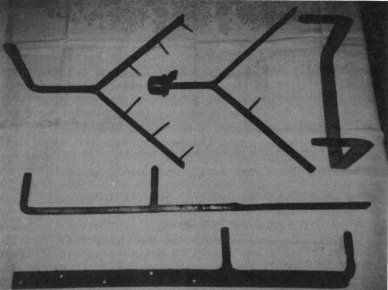Insulator Brackets
by R. M. Settle
Reprinted from "INSULATORS - Crown Jewels of the Wire", June 1974, page 9
In the October 1973 issue you printed some correspondence pertaining to
different styles of CAST iron insulator brackets. The information was very
interesting to me because I've been doing some research on bracket styles used
here in Eastern Canada to support threadless insulators a hundred or more years
ago on telegraph lines running through urban areas, and what I've found I think
will be of interest to many other collectors
Here's a polaroid snapshot of six different brackets I've collected. All are
of hand-wrought, FORGED iron, and one still has a chunk of black glass, C.D.
740, firmly cemented in place with burlap and tar. Two of these brackets still
contain what appear to be the original forged-iron nails used to fasten them to
a chimney.

There seems to be a considerable difference in bracket styles to be found.
With some kinds I've seen as many as four pins on a single fixture. But I think
most of these multiple pin brackets were manufactured since the advent of
threaded insulators, and perhaps even since the telephone came into general use.
I've seen them installed where one would expect telephone lines to go, but far
from the logical path of a telegraph line. Other brackets, especially those with
a single pin, were found along the paths of telegraph lines between telegraph
offices and early rail lines, located with the aid of an 1865 map.
One common feature, however, distinguishes the brackets in the picture from
the types I've seen elsewhere. The pins are not threaded at all. They are
hammered more-or-less round, and several small chisel-points of the iron have
been raised at random intervals to grip the burlap which was then tarred before
the insulator was pressed into place. I understand this burlap cushion absorbed
the expansion and contraction of the iron and the glass caused by fluctuations
in temperature.
Some collectors I've contacted have informed me that brackets of this general
description were manufactured and sold by several electrical equipment supply
houses in the 1880's. Colin McIntosh of Victoria, British Columbia, sent me a
Xeroxed page from a Tillotson catalogue which proves Tillotson sold similar
brackets at that time. But I think these were most likely threaded, because
threaded glass insulators are advertised on the same page. At any rate, the
fixtures illustrated in the Tillotson catalogue appear to be somewhat more
refined than the hand-forged ones I have found.
Now maybe, just MAYBE, other insulator buffs are interested in this sort of
paraphernalia, too, and our great little magazine can serve as a forum for
ideas, opinions, and researched information on the subject of pioneer
experiments in the design of insulator brackets, to supplement what we are still
learning about our first love, INSULATORS!
| 